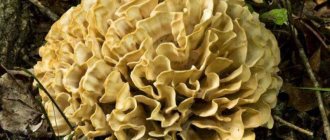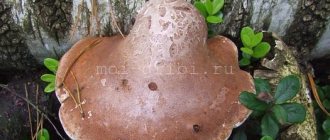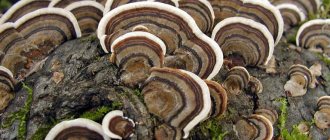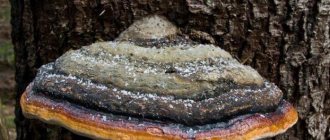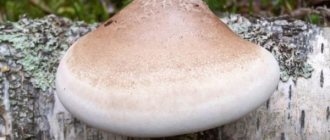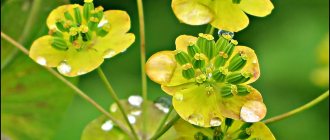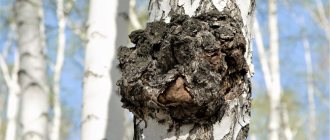Systematics, characteristics and description of the structure of the parasitic fungus
The true tinder fungus is sometimes also called the blood sponge; it bears the Latin name Fomes fomentarius; there are also synonyms: Polyporus fomentarius, Boletus fomentarius, Ungulina fomentaria, Fomes griseus. Belongs to the genus Phomes of the Polyporaceae family.
Mushrooms are sessile, without stalk. The cap of young specimens is rounded, then becomes like a hoof. It is attached to the tree by the center of the upper part. The mushroom is perennial, reaches a diameter of 40 cm, and can be up to 20 cm in height. The surface is matte, stepped, with ridges. Sometimes covered with small cracks. The color ranges from light gray to dark, with occasional beige shades.
The hymenophore, the lower part of the cap, consists of tubes, the pores of which are quite large and light-colored. They darken when pressed. The spores are white.
The pulp is very dense, hard, cork-like, often woody. The cut is usually velvety and does not change color. The color is brown or reddish-brown.
A little history
The first mention of this mushroom belongs to the Swedish scientist, naturalist and physician, Carl Linnaeus. He described the tinder fungus at the beginning of the 18th century, but in 1849, compatriot Elias Magnus Fries changed the generic affiliation of this species.
What it looks like and where it grows
The mushroom is considered a saprophyte. The true polypore grows mainly on dead trees. Other names of the species associated with external characteristics are also known:
- blood sponge;
- hoof mushroom.
The real tinder fungus has characteristics of growth and development. Initially, the mushroom looks like a droplet. It seems to seep through the wood. Gradually the fruiting body enlarges and takes on a characteristic appearance.
It is noteworthy that the true tinder fungus is not attached to trees by means of a stalk. The mushroom is attached to the bark with a cap. It is not a toxic specimen. The fruiting bodies are not used in cooking due to the excessive hardness of the pulp.
The leg of the real tinder fungus is completely absent. The mushroom is distinguished by its large wavy and matte cap. Its diameter is up to 40 cm, and its thickness is 20 cm. Small cracks can be seen on the surface. Color varies from light to dark shades of gray. This characteristic depends on age characteristics. Old mushrooms have a rich color.
The pulp of the true tinder fungus has the consistency of a cork. The cut is characterized by a velvety texture. The color of the pulp has the following shade options:
- brown;
- walnut;
- brown.
The spore powder is white in color. The true tinder fungus feeds on the remains and sap of rotting or dead wood. The fungus can cause white rot. This leads to thinning of tissues and their fragility.
The blood sponge is widespread throughout Europe. The fungus parasitizes the following types of trees:
- birch;
- oak;
- alder;
- aspen;
- beech.
Often, the real tinder fungus settles on weakened wood. It is known that infection occurs through cracks or damage to the bark. The appearance of blood sponge is also caused by broken branches. Fruiting bodies begin development in the spring. The growth period lasts until late autumn.
Polypore, which has medicinal properties, lives on living trees
Growing at home and in the country
Polypore is grown quite rarely, mainly for medicinal purposes. To do this, you will need to purchase fungal mycelium and prepare pieces of wood at least 50 cm long and 25 cm in diameter. You can also use a dead tree or stump.
In order to introduce mycelium, you will need to drill holes or saw bars, then populate the spores and seal with adhesive tape. The top should be covered with straw or burlap. The mycelium will overgrow after 10 months if the temperature is within +7+27 0C.
Reference! Breeding should take place in the coolest and most shaded corner of the garden, and the fruits can be collected for medicine for 5 years in spring or autumn.
Polypores are easy to prepare for future use:
Sun drying
- Clean the fruit bodies from dirt and damaged fragments and wipe with a damp cloth.
- Cut into medium sized pieces.
- Thread onto a thread, making sure that the pieces do not touch each other.
- Hang to dry in a sunny place. You can lightly cover the pieces with a layer of gauze on top to protect them from insects.
Salting for the winter
Required:
- Salt – 120 gr.
- Peeled and boiled mushrooms – 3 kg.
- Garlic – 5-6 medium sized cloves.
- Bay leaf – 6 pieces.
- Black peppercorns - about 30 pieces.
- Dill to taste.
The ingredients are placed in the pickling container in this order:
- Chopped garlic, bay leaf, dill and black pepper.
- Mushrooms in a 7 cm layer, then cover them with salt.
- Repeat this combination of layers until the edge of the container.
- Cover the top with a thick napkin, place under a load and put away in a dark place for a month.
Edibility, medicinal properties, beneficial properties and contraindications
This mushroom was called a blood sponge for its ability to stop blood. It contains so many beneficial elements that it is suitable for the treatment of most common diseases. And most importantly, polypore has the ability to stop the development of cancer cells, so it is often used to prevent this particular disease.
The true tinder fungus is inedible. Sometimes an allergic reaction occurs to mushrooms, in which case it is prohibited to use them as medicine.
In addition, in ancient times, tinder was used to make many useful things in everyday life, and was also used to produce tinder, which can easily ignite, repel unwanted insects and maintain a smoldering fire.
Polypore bordered
The edged type of mushroom has a round or hemispherical shape. You can find it in most regions of Russia and Europe. The drone successfully reproduces and grows on spruce wood and other trees.
How to recognize
External signs by which you can recognize a drone:
- Form of growth. The sizes are average within 20-30 centimeters. In older individuals it can reach half a meter. The height of the growth varies from 4 to 10 centimeters. The surface is distinguished by concentric circles. Each of them has its own shade.
- Pulp. Elastic and dense, reminiscent of a cork. When broken, flakes can be seen. Depending on the age of the fetus, the color can vary from beige to brown.
The mushroom has no stem.
Properties
The fringed drone is an edible mushroom. In terms of taste and edibility, it is similar to albatrellus (sheep tinder fungus). It is often added to mushroom seasonings. The species is also used to make a variety of medicines in homeopathy. You can also find a specimen in Chinese medicine.
The tinder fungus poses a serious threat to lumber yards. The species causes considerable damage to warehouses in Siberia. It leads to active rotting of wood blanks from a variety of species.
Chemical composition and economic importance
The true polypore contains a large amount of proteins and carbohydrates, it has a lot of fiber and resinous substances, and it is also famous for its content of B vitamins, manganese, potassium, selenium, phosphorus and zinc.
Due to the high rigidity of the fruiting bodies, various household utensils were often made from tinder fungi. Its porous part was used for sharpening knives, and its suede surface was used for making clothing, such as slippers, hats and hand muffs. A large number of crafts and souvenirs made from tinder fungus were popular. Unprocessed mushrooms produce unique interior items that are sold in stores to this day.
Common tinder fungus
Also called common liverwort or mother-in-law's tongue. The reason is the red color of the fruiting body and the release of brown juice when broken. It does not differ in any characteristic aroma. The taste is either completely absent or has a sourish tint.
How to recognize
Characteristics of the common tinder fungus:
- Hat. From 7 to 30 centimeters. At the base the cap is thick - from 5 to 8 centimeters. The shape is irregular, the surface is sticky and damp. The color is brownish-red, reddish-orange or reddish-brown.
- Leg. Poorly expressed, located on the side. It may be completely absent or in its infancy. Strong, thick.
- Pulp. Whitish with a red tint. The pattern is similar to marble, looks very beautiful and aesthetically pleasing.
Properties
You can find it on chestnut trunks and other deciduous trees. The liverwort grows singly or in small groups. The specimen can be found at the base of trees from June to October.
“Mother-in-law’s tongue” can be eaten. It is better not to use old specimens due to their pronounced sour taste. It is due to the large amount of vitamin C contained in the mushroom.
Use in folk medicine
In folk medicine, internal spongy tissue is used to prepare infusions, it is dried or decoctions are prepared. The most common use of a blood sponge is to stop bleeding by applying it externally to a wound. It has a bactericidal effect. It also helps with painful menstrual bleeding and in the treatment of hemorrhoids, and in the 19th century its hemostatic properties were used by dentists and surgeons.
The resins contained in the body of the mushroom help cope with viruses and bacterial infections. They are able to overcome pathogenic bacteria of the biliary and pulmonary tracts, liver, and can cope with pneumonia, tuberculosis, hepatitis (for this they use a decoction of powder). It’s easy to prepare; just boil 1 tsp in 200 ml of water. tinder powder for 20 minutes. A lotion made from this composition will help with bruises. And if you drink a decoction of 1 tbsp. l. three times a day before meals for 3 months, it can reduce blood sugar in a diabetic.
A tincture of tinder fungus is prepared using vodka or natural Cahors. To prepare, mix 50 g of mushroom powder and 0.5 liters of alcoholic drink. Seal and leave for 15 days in a cool place. You should drink 10 ml per day for 3 months. This drink is an excellent remedy for cancer prevention.
Important! Mushroom preparations are prohibited for use by children under 12 years of age, as well as by pregnant and lactating women.
Methods of preparation and use
Traditional medicine uses the pulp of the birch polypore to prepare several medicines. They can be used externally and internally.
Tincture of birch polypore
An alcoholic tincture of tree mushroom is beneficial for nervous disorders and sleep disorders. It is made according to this recipe:
- dry tinder fungus is ground to a powder in an amount of 200 g;
- pour 500 ml of high-quality vodka into the raw material;
- seal the vessel and put it in a dark place for three days;
- strain the medicine from the sediment.
Take the finished tincture one small spoon an hour before going to bed. The course of treatment must be continued for three weeks.
Birch polypore tincture is suitable for rubbing joints for arthritis and rheumatism
Infusion
For cardiovascular ailments and intestinal diseases, you can take a water infusion of tree mushroom. The recipe for preparing the product looks like this:
- dry mushroom is crushed in the amount of two small spoons;
- pour the resulting powder into 200 ml of hot clean water;
- closed, leave to infuse for two days;
- After time, filter the product and pour it into a new container.
You need to take the infusion 15 ml three times a day on an empty stomach.
It is not recommended to brew birch polypore in boiling water, as this destroys the beneficial substances in the composition.
Powder
One of the recipes for using birch tinder fungus recommends using dry fruiting body powder. Medicinal raw materials disinfect damage and promote rapid skin restoration. Wounds and ulcers are washed with peroxide or alcohol, and then sprinkled with mushroom powder and a sterile bandage is applied on top.
Multi-colored tinder fungus
The multicolored tinder fungus has received many different names due to its appearance. Yun-ji, turkey tail, variegated tinder fungus - all this is the same mushroom. You can find multi-colored trametes from the end of June to the end of October. The multi-colored tinder fungus is very fond of rotten stumps and dried trees. But the species does not like coniferous species; it almost never settles on spruce and pine bark.
How to recognize
Character traits:
- Fruiting body. The mushroom is flat to the touch. Width from 3 to 6 centimeters, length from 6 to 9 centimeters. The leg is absent; the individual is a sessile species.
- Hat. No more than 10 centimeters in diameter, semicircular. The individual grows in groups. The surface of the cap is felt-velvety and pleasant to the touch. The mushroom is colorful and visible from afar.
- Pulp. Light and very thin. Has a pleasant smell.
Properties
You can meet the multi-colored tinder fungus in almost any forest on our planet. It has beneficial properties that are highly valued in Chinese medicine. Products based on multi-colored mushrooms help improve cellular immunity and improve liver function. Moreover, the mushroom is completely inedible. Under no circumstances should it be used in the kitchen.
Birch tinder fungus (oblique)
Other species names:
- Oblique.
- Chaga.
- Black mushroom.
- Birch sponge.
- Mown mushroom.
It is named birch due to active reproduction on this tree. Also loves aspen bark, rowan and willow. The parasite is based on the bark, in places where there are cracks. It may remain there for several years in a row.
How to recognize
External characteristics:
- Form. Sizes vary from 7 to 25 centimeters. The shape is hemispherical. Wrong. The surface is black with a brown tint, covered with cracks, lumpy. On dead trunks, the specimen stops its development and life cycle. As the fungus grows, it gradually destroys the tree bark.
- Pulp. The woody pulp is brown or brown in color. Has white veins. The older the individual, the darker its flesh. Has no smell.
The leg is missing.
Properties
Birch tinder fungus cannot be used as food. But at the same time, it can be used in folk medicine. It helps with diseases of the gastrointestinal tract, liver and kidney diseases.
The tinder is real
You can see an example very often. The fruiting body at the beginning of the life cycle has a round shape, but over time it becomes hoof-shaped. It grows on deciduous trees: oaks, aspens, birches, alders. It can be found almost throughout Europe, just like the maple tinder fungus.
How to recognize
Character traits:
- Fruiting body. The stalk is absent, so the fruiting body is considered sessile. The width reaches 40 and the height 20-25 centimeters. The skin is very wavy, matte, darker in the recesses. Cracks are often found on the surface. The shade is gray, reminiscent of the color palette of tree bark. In very rare cases the shade may be beige.
- Pulp. Dense, soft, similar to cork. Can sometimes be woody. When cut, it is velvety and pleasant to the touch, similar to suede. The color of the pulp is nutty, brown or reddish.
Properties
Real tinder fungus is not eaten. He is a parasite. If a tree becomes infested with polypore fungus, it will likely die soon. Proper removal of the tinder fungus rids the plant of the parasite.
The pulp of the mushroom has medicinal properties. Used by traditional healers to prepare a hemostatic agent. Due to this, the individual was nicknamed the “blood sponge.”

